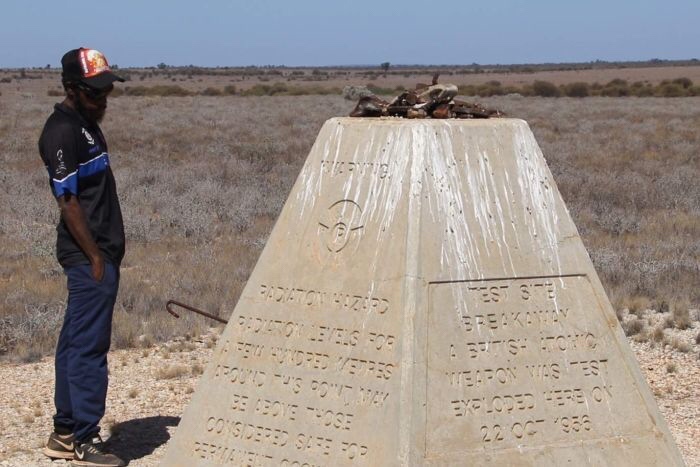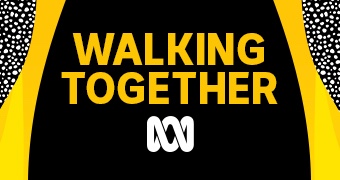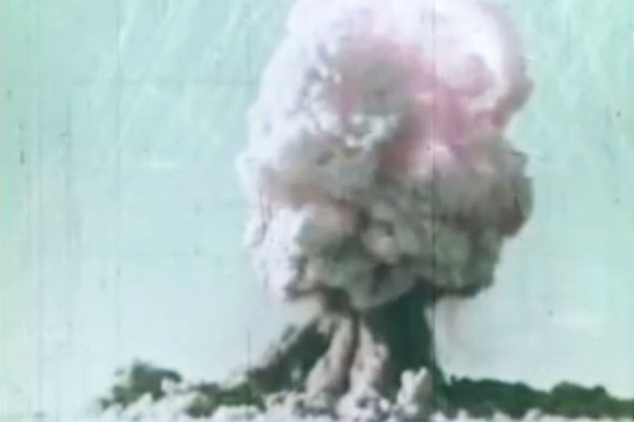The lesser known history of the Maralinga nuclear tests — and what it’s like to stand at ground zero
By Mike Ladd for The History Listen
Mon at 2:00pmMon 23 Mar 2020, 2:00pm
Posted Mon at 2:00pm
Photo: It’s not until you stand at ground zero that you fully realise the hideous power of these nuclear tests. (ABC News)
I thought I knew all the details about Maralinga, and the nuclear bomb tests that took place there six decades ago.
But when I set out to visit ground zero, I realised there were parts of this Cold War history I didn’t know — like Project Sunshine, which involved exhuming the bodies of babies.
Between 1956 and 1963 the British detonated seven atomic bombs at the site; one was twice the size of the bomb dropped on Hiroshima.
There were also the so-called “minor trials” where officials deliberately set fire to or blew up plutonium with TNT — just to see what would happen.

Photo: Years ago it would have been dangerous to visit this area. (ABC RN: Samantha Jonscher)
One location called “Kuli” is still off-limits today, because it’s been impossible to clean up.
I went out to the old bomb sites with a group of Maralinga Tjarutja people, who refer to the land around ground zero as “Mamu Pulka”, Pitjantjatjara for “Big Evil”.
“My dad passed away with leukaemia. We don’t know if it was from here, but a lot of the time he worked around here,” says Jeremy Lebois, chairperson of the Maralinga Tjarutja council.

Photo: Jeremy Lebois is hopeful that one day, the landscape will return to normal. (ABC News: Samantha Jonscher)
Thirty per cent of the British and Australian servicemen exposed to the blasts also died of cancer — though the McClelland royal commission of 1984 was unable to conclude that each case was specifically caused by the tests.
Even after more than 60 years, the vegetation is cleared in a perfect circle with a one kilometre radius.
“The ground underneath is still sterile, so when the plants get down a certain distance, they die,” explains Robin Matthews, who guided me around the site.

Photo: Robin Matthews works as a guide in the area, which is now safe to visit. (ABC News: Samantha Jonscher)
The steel and concrete towers used to explode the bombs were instantly vaporised.
The red desert sand was melted into green glass that still litters the site.
Years ago it would have been dangerous to visit the area, but now the radiation is only three times normal — no more than what you get flying in a plane.
The Line of Fire
Australia was not the first choice for the British, but they were knocked back by both the US and Canada.
Robert Menzies, Australia’s prime minister at the time, said yes to the tests without even taking the decision to cabinet first.
David Lowe, chair of contemporary history at Deakin University, thinks Australia was hoping to become a nuclear power itself by sharing British technology, or at least to station British nuclear weapons on Australian soil.
“In that period many leaders in the Western world genuinely thought there was a real risk of a third world war, which would be nuclear,” he says.

Photo: Prime Minister Robert Menzies believed the nuclear tests were a chance to work with Britain. (Getty: PA Images)
The bombs were tested on the Montebello Islands, at Emu Field and at Maralinga.
The Blue Streak rocket was developed and test-fired right across the middle of Australia, from Woomera all the way to the Indian Ocean, just south of Broome.
This is known as “The Line of Fire”.
“The Line of Fire from Woomera to Broome is, funnily enough, the same distance from London to Moscow,” Mr Matthews says.

Photo: The Line of Fire, from Woomera in South Australia to Broome in Western Australia. (Google Maps)
Just as the Maralinga Tjarutja people were pushed off their land for the bomb tests, the Yulparitja people were removed from their country in the landing zone south of Broome.
Not all the Blue Streak rockets reached the sea. Some crashed into the West Australian desert.
The McClelland royal commission showed that the British were cavalier about the weather conditions during the bomb tests and that fallout was carried much further than the 100-mile radius agreed to, reaching Townsville, Brisbane, Sydney and Adelaide.
“The cavalier attitude towards Australia’s Indigenous populations was appalling and you’d have to say to some extent that extended towards both British and Australian service people,” Professor Lowe says.
There are also questions over whether people at the test sites were deliberately exposed to radiation.
“You can’t help but wonder the extent to which there was a deliberate interest in the medical results of radioactive materials entering the body,” Professor Lowe says.
“Some of this stuff is still restricted; you can’t get your hands on all materials concerning the testing and it’s quite likely both [British and Australian] governments will try very hard to ensure that never happens.”
We do know that there was a concerted effort to examine the bones of deceased infants to test for levels of Strontium 90 (Sr-90), an isotope that is one of the by-products of nuclear bombs.
These tests were part of Project Sunshine, a series of studies initiated in the US in 1953 by the Atomic Energy Commission.
They sought to measure how Sr-90 had dispersed around the world by measuring its concentration in the bones of the dead.
Young bones were chosen because they were particularly susceptible to accumulating the Sr-90 isotope.
Around 1,500 exhumations took place, in both Britain and Australia — often without the knowledge or permission of the parents of the dead.

Photo: The faded crest of Maralinga’s Range Support Unit. (ABC RN: Mike Ladd)
Again, it was hard to prove conclusively that spikes in the levels of Strontium 90 during the test period caused bone cancers around the world.
The Maralinga tests occurred during a period that Professor Lowe describes as “atomic utopian thinking”.
“Remember at that time Australians were uncovering pretty significant discoveries of uranium and they hoped that this would unleash a vast new capacity for development through the power of the atom,” he says.
Project Ploughshare

Photo: A painting from the old servicemen’s bar at Maralinga. (ABC News: Samantha Jonscher)
Some of the schemes were absurdly optimistic.
Project Ploughshare grew out of a US program which proposed using atomic explosions for industrial purposes such as canal-building.
In 1969 Australia and the US signed a joint feasibility study to create an instant port at Cape Keraudren in the Kimberley using nuclear explosions.
The plan was dropped, but it was for economic not environmental or social reasons.
The dream (or was it a nightmare?) of sharing nuclear weapons technology with the British was never realised.
Walking Together

An ABC-wide initiative to reflect, listen and build on the shared national identity of Indigenous and non-Indigenous people.
All Australia got out of the deal was help building the Lucas Heights reactor.
The British did two ineffectual clean-ups of Maralinga in the 1960s.
The proper clean-up between 1995 and 2000 cost more than $100 million, of which Australia paid $75 million.
It has left an artificial mesa in the desert containing 400,000 cubic metres of plutonium contaminated soil.
The Maralinga Tjarutja people received only $13 million in compensation for loss of their land, which was finally returned to them in 1984.

Photo: The red dirt and scattered trees of the Maralinga landscape. (ABC RN: Mike Ladd)
As we were leaving the radiation zone, the Maralinga Tjarutja people spotted some kangaroos in the distance.
Over the years some of the wildlife has started to return.
Mr Lebois takes it as a good sign.
“Hopefully, hopefully everything will come back,” he says.

Walking Together is taking a look at our nation’s reconciliation journey, where we’ve been and asks the question — where do we go next?
Join us as we listen, learn and share stories from across the country, that unpack the truth telling of our history and embrace the rich culture and language of Australia’s First People.
No comments:
Post a Comment